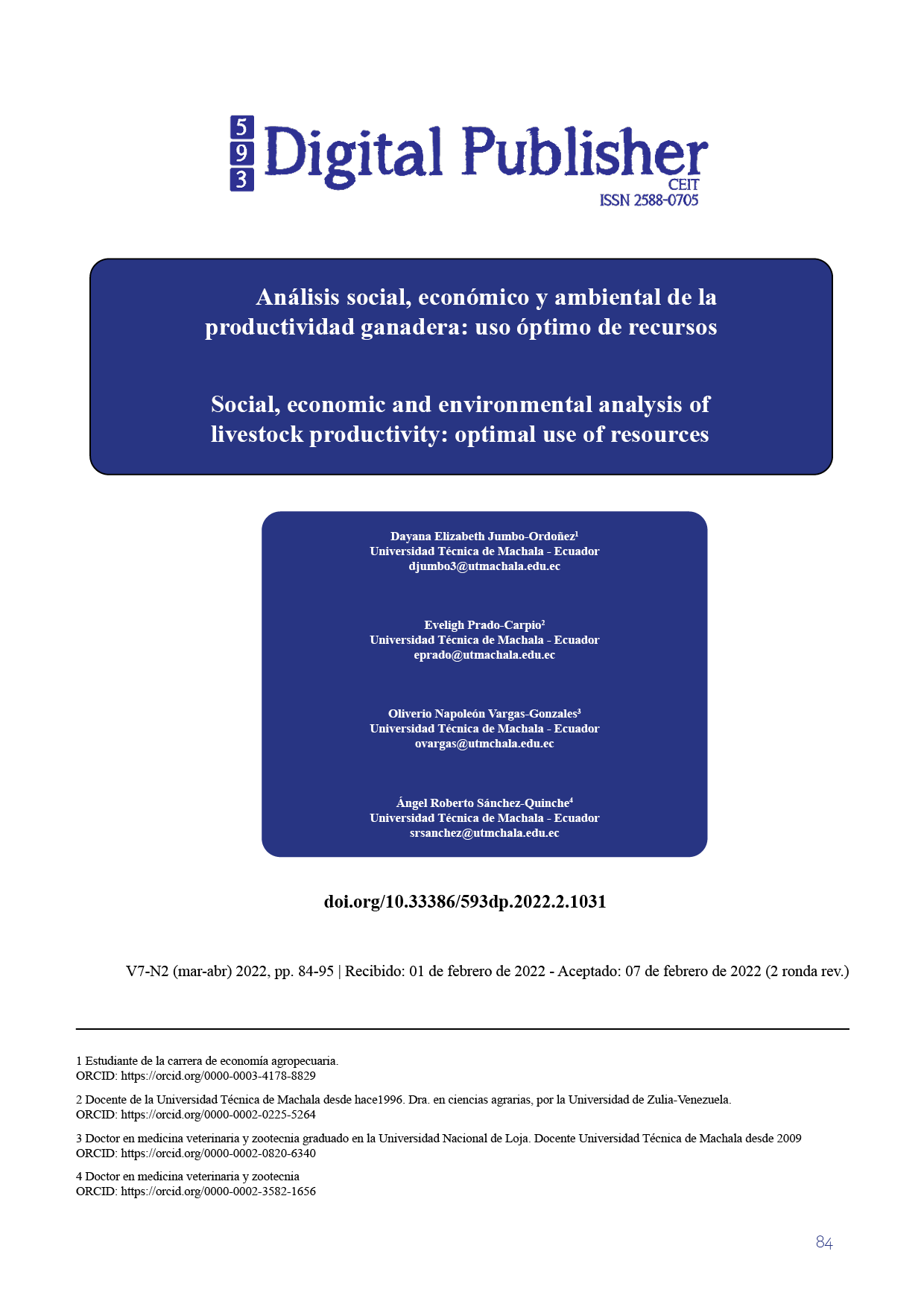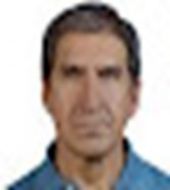Social, economic and environmental analysis of livestock productivity: optimal use of resources
Main Article Content
Abstract
The purpose of this research is to diagnose the social, economic and environmental factors that influence livestock productivity. The methodology applied is based on the compilation and analysis of bibliographic information contained in books, academic articles, national and international reports.
In addition, this research considers a non-experimental, cross-sectional, argumentative and strategic design, obtaining information in questions directed to three farms, through a descriptive methodological outline with quantitative and qualitative variables.
The results showed that 66.7% of livestock production is underutilized, with the highest concentration of this activity located in the Sierra region, below 80%. It was determined that the livestock sector has had a considerable contribution represented in last year's Gross Domestic Product (GDP) (8.2%).
It is concluded that livestock productivity must be aligned with the objectives of sustainable development, which considers feasible alternatives to convert losses into profits, to generate profitability, stability, and innovation, contributing to sustained and timely growth at the local and national levels and thus expand to international networks.
Downloads
Article Details

This work is licensed under a Creative Commons Attribution-NonCommercial-ShareAlike 4.0 International License.
1. Derechos de autor
Las obras que se publican en 593 Digital Publisher CEIT están sujetas a los siguientes términos:
1.1. 593 Digital Publisher CEIT, conserva los derechos patrimoniales (copyright) de las obras publicadas, favorece y permite la reutilización de las mismas bajo la licencia Licencia Creative Commons 4.0 de Reconocimiento-NoComercial-CompartirIgual 4.0, por lo cual se pueden copiar, usar, difundir, transmitir y exponer públicamente, siempre que:
1.1.a. Se cite la autoría y fuente original de su publicación (revista, editorial, URL).
1.1.b. No se usen para fines comerciales u onerosos.
1.1.c. Se mencione la existencia y especificaciones de esta licencia de uso.
References
Barrero, D. (2017). Estrategia Regional de Ganadería Sostenible. Organización de las Naciones Unidas para la Alimentación y la Agricultura. Costa Rica: CODEGALAC. Recuperado el 17 de 11 de 2021
Barsky, O., Barril, A., Cosse, G., Morandi, J., & Humberto, V. (03 de 1980). El proceso de transformaciòn de la producciòn lechera serrana y el aparto de generaciòn transferencia en Ecuador. Protaal(40), pág. 31. Recuperado el 12 de 11 de 2021
Barzola, S. (2013). ESTUDIO DE CADENAS PECUARIAS DE ECUADOR. Quito: Ministerio de Agricultura, Ganaderìa y Pesca.
CEPAL, & FAO. (1986). Crecimiento Productivo y Heterogeniedad Agraria. Santiago de Chile: Biblioteca CEPAL. Recuperado el 12 de 11 de 2021
Chaves, R., Salazar, D., Orejuela, D., Culchàn, M., Suàrez, M., & Villafuerte, W. (2012). Encuesta de Superficie y Producción Agropecuaria Continua ESPAC. Quito: INEC.
Moncada, A., & Àvila, E. (2019). Integrando la Reversión de Degradación de Tierras y Reducción del Riesgo de Desertificación en Provincias Vulnerables. Quito: Medio Ambiente Mundial. Recuperado el 12 de 11 de 2021
Ollague, J., Capa, L., Novillo, E., Sanchéz, T., Sanchéz, L., & García, M. (2019). Variables sociales, económicas y productivas como referente de posicionamiento nacional de la provincia de El Oro, Ecuador. Espacios, 17. Recuperado el 18 de 01 de 2022
Prado Carpio, E., Martínez Soto, M., Monroy Rodrìguez, C., & Unda Barrezueta, S. (Diciembre de 2020). GESTIÓN DE AGRONEGOCIOS Y EL DESEMPEÑO DE LA CADENA DE VALOR DE LA CONCHA PRIETA “ANADARA TUBERCULOSA”. ResearchGate, 302. Recuperado el 24 de 11 de 2021
Riojas, I., Badii, M., Guillen, A., García, M., & Abreu, J. (11 de 2018). La ganadería y el desarrollo sustentable. International Journal of Good Conscience, 77-102. Recuperado el 17 de 11 de 2021
Sànchez, A., Vayas, T., Mayorga, F., & Freire, C. (2019). Sector Ganadero. Ambato: INEC, ESPAC. Recuperado el 12 de 11 de 2021
Tannahill, R. (1973). Ganaderia y Cria de Animales. En M. L. Myers, Ganaderia: Ambito y sobre la Salud (págs. 42-70). Nueva York: Enciclopedia de Salud y Seguridad en el trabajo. Recuperado el 12 de 11 de 2021
Valverde, T. (9 de 01 de 2013). Ánalisis estadístico de la influencia de la fiebre aftosa en el desarrollo del sector ganadero. Quito, Quito, Ecuador. Recuperado el 18 de 01 de 2022
Villegas, Z. V. (2019). Conducta de la hembra Bovina Lechera durante el ordeño en una finca productiva en la Provincia de El Oro. Machala, El Oro, Ecuador. Recuperado el 18 de 01 de 2022
Vite, H., & Vargas, O. (2018). Ganadería de precisión en la provincia de El Oro: Diagnostico situacional. Espirales, 13. Recuperado el 18 de 01 de 2022
Vizcarra, R., Lasso, R., & Tapia, D. (2015). La Leche del Ecuador. Quito: Effecto Studio. Recuperado el 18 de 01 de 2022





